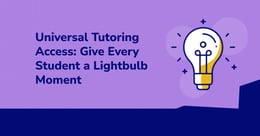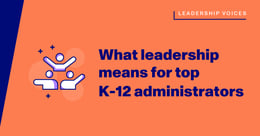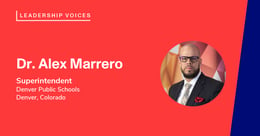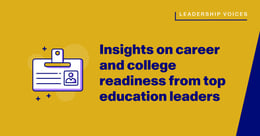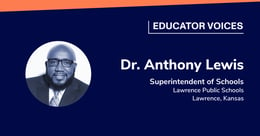
Tuning in to what students need: Learning and well-being
When challenging circumstances erode the underlying conditions that make learning possible, academic success can become precarious.
Today in our school system, district leaders are facing down several stubbornly persistent issues that emerged during the pandemic. K-12 institutions are called upon to fill many roles, and now, reengaging with students requires new approaches.
We spoke with leading superintendents from across the country about how they’re setting learners up for success—even when it feels like the ground is moving under their feet.
What we heard, time and again, was that bringing students back into the fold will take time, resources, and a multifaceted approach that requires teachers and districts alike to embrace new ways of doing things.
The rocky road back to in-person learning
As learning moved from shared classrooms to individual devices during the outset of the COVID-19 pandemic, schoolhouses transformed overnight from vibrant centers of community life to shuttered buildings. But what changed in an instant will take a long time to recover from. A significant cost of the pandemic’s widespread disruptions is now coming due in the form of children’s social and academic development.
Dr. Angélica M. Ramsey of the Fort Worth Independent School District in Texas noted that the sudden move to distance learning had an outsized impact on younger students in particular. For example, learners who were in third grade by spring 2023 likely missed out on all or portions of in-person kindergarten, first grade, and second grade.
“Building that foundation for literacy and numeracy—it was on a screen,” said Ramsey. “You also have the social aspect.”
As a result, schools have to help learners get back on track both academically and socially. And for the youngest students, that means figuring out what it’s like to learn in person for the first time in their lives.
Growing concern around technology literacy and social media issues
Districts are also finding that older students are still navigating a bumpy road even this long after returning to in-person instruction. Amid the feelings of isolation that were brought on by the pandemic, many learners leaned into social media and technology. The effects weren’t always positive, and it can feel like schools have a lot of ground to make up.
“We’re really focused also on reengaging with our community,” said Dr. Kimberley Cantu of Texas’ Mansfield Independent School District. “During the pandemic, everybody—I think—got real comfortable sitting behind their laptop.”
As students continue to readjust to in-person school environments, they’ll require additional support. In part, that means helping them shake some unhelpful habits they may have picked up while spending extra time online during the era of distance learning.
“If someone’s read your message, have they responded?” said Dr. Anthony Rossetti of Webb City Schools in Missouri. “I could not even begin to understand some of those things when I was an adolescent, let alone as a student who’s trying to find their way and identity growing up in a world today where they get bombarded with all types of information.”
K-12’s role in a changing environment
Given the emotional and educational upheavals that have accompanied the past couple of years, a top priority for forward-thinking district leaders is to build out a comprehensive support system for students and their families. That means providing a first-rate academic experience, of course, but learners’ social, emotional, and physical needs are also coming to the fore. Administrators are focusing on the community school model, providing new opportunities for their students, and prioritizing mental health.
Community schools: Meeting families’ needs
In many places around the country, public schools serve not only as centers of education but also as clearinghouses for extensive community resources.
Albuquerque Public Schools’ Scott Elder told us all about how school districts in New Mexico serve meals for thousands of students while connecting them and their families to doctors, dentists, mental health practitioners, and other health care providers.
“For a lot of these families that are really struggling, it’s nice to have those services directly in their neighborhood where they can access them easier,” said Elder. “I don’t know that the public always understands exactly how large a burden has been placed on the public schools to fill in a lot of gaps that exist.”
Mentoring, restoration, and space for wellness
Meeting students’ social and emotional needs is a multifaceted endeavor, but it’s an essential part of setting the stage to make lifelong learning and future success possible—particularly given the unique challenges today’s learners face.
For some students, gaining access to supportive mentors and participating in cultural experiences that broaden their horizons are key vehicles for dreaming bigger and retaking control of their lives.
“We have a full-time person who works with recruiting mentors, making sure they’re going through background checks and making sure they’re being trained,” said Trent North of Georgia’s Douglas County School System.
North added that the district also sponsored cultural exchange trips for essay winners to travel abroad to Portugal and Peru, all expenses paid. The superintendent hopes participating students will gain a new perspective as they explore life beyond their familiar surroundings.
Building up a robust support network at home can also help students feel safe to pursue their interests and curiosities. When Dr. John M. Craft told us about his experience with Texas’ Killeen Independent School District, he shared that—in addition to providing meals, school supplies, and clothes for families in need—the district emphasizes restorative practices that strengthen relationships among teachers, students, and families.
“The students have to know that you truly care about them as an individual,” said Craft.
Creating the physical space required for prioritizing well-being can also go a long way toward promoting wellness in school communities.
“In every school, in every classroom that I visited—whether it was a kindergarten classroom, seventh grade classroom, or a high school classroom—I was able to see either a wellness corner within the classroom or wellness spaces for students within that school that gave an environment of support, nurturing, and relaxation,” said Dr. Monifa B. McKnight of Montgomery County Public Schools in Maryland.
Targeted support for mental health
Now more than ever, students’ unique mental health needs require schools to expand their efforts. Dedicated mental health services can help students continue to readjust to the classroom environment and unburden themselves from the difficulties and distractions they face.
As Dr. Marvin Connelly Jr. of North Carolina’s Cumberland County Schools notes, strong mental health is a prerequisite for successful teaching and learning.
“The mental health impact of the pandemic was very significant,” said Connelly. “Our focus has been on getting children whole first and getting adults whole, and then the learning will recover.”
In addition to in-person mental health support for students, staff, and school leaders, some districts have embraced technology to roll out services in a way that could reach individuals who may otherwise be reluctant to seek out help.
“They can see a mental health provider in the comforts of their home with no one even knowing,” said Dr. Monica Goldson of Prince George’s County Public Schools in Maryland. “Their parents can join those sessions, and they can begin to find a place of healing and strategies to help them move forward.”
Innovative educational practices for 21st-century learning
Alongside providing services and opportunities that promote wellness, security, and connection beyond the classroom, our moment demands that school leaders also find new ways to support students in their studies. That means exploring new subject matter and potentially rethinking some of the traditional structures of K-12 education.
As students reacclimate to the educational environment, how can we be sure that what they’re learning truly reflects where our world is headed? We heard from superintendents about new focus areas for learning, how teachers are shifting their approaches, and systematic changes at the district level.
Media literacy for the digital age
In the years to come, artificial intelligence will continue to gain prominence, and facts and figures will be readily accessible. Dr. Christopher Bernier of Florida’s Lee County School District believes the ability to think critically and analytically will become increasingly important. In short, students will need to know how to assess what’s in front of them.
“You could get a brief—you could get a position paper for your employer written by artificial intelligence—but if you can’t explain it, and you can’t implement it, then what good is it?” asked Bernier. “What we have to do is teach them how to use that information and be good global citizens and great employees and great leaders.”
[READ: “Driving impact: Paper’s approach to AI in education”]
Autonomy and risk-taking for teachers
The trials and tribulations of recent years have put teachers under immense strain. To support students through all the challenges they’re facing, we have to empower teachers.
As administrators focus on making sure their teachers know about all the resources in place to help them thrive, some districts are also taking the opportunity to encourage educators’ bold new ideas.
“In the past, some people have thought, ‘You know, if I tried something new and it didn’t work, I was going to get in trouble,’” said Dr. Melvin J. Brown of Montgomery Public Schools in Alabama. “We’re really trying to change that culture in regard to how people look at the work.”
[READ: “Teacher burnout also impacts students. Here’s how.”]
Thinking big in the central office
In the current climate, some education leaders believe that a certain amount of structural change is necessary to better support students and teachers in the classroom. At the district level, administrators are taking action to ensure their school systems are responsive to the urgent needs of educators, learners, and families.
For Dr. Andi Fourlis of Mesa Public Schools, that means working with nearby Arizona State University and reexamining classroom models and teacher support.
“We are getting rid of that ‘one teacher, one classroom’ idea and creating teams of teachers and specialists who wrap around students to design deeper and more personalized learning so that our children can thrive,” said Fourlis. “It’s no longer doable for one teacher to be able to serve 25 students.”
Embracing new tools and resources—and effectively implementing them across districts by being persistent and carefully explaining their benefits—can help district leaders give students the additional support they need to bounce back and excel in a 21st-century environment.
“We needed to find solutions where kids can have extended learning opportunities,” said retiring Superintendent Addison Davis of Florida’s Hillsborough County Public Schools, citing Paper™ as one such solution. “Communication is everything, and from the first year of implementation to the second, you see that we’re starting to move the matrix with greater implementation.”
The bookends of K-12: From early childhood to life after graduation
The difficulties our youngest learners have faced since the onset of the pandemic underscore the importance of early childhood education. Likewise, the rapidly accelerating pace of technological progress in a changing global economy indicates a strong need for high schools to help students move forward with a clear sense of purpose.
[READ: “The K-12 guide to career and college readiness”]
District leaders from throughout the country made it clear that K-12 is not the sum total of a student’s educational journey. As such, superintendents are thinking creatively about how they can ensure that young learners have access to robust pre-K programs while high school students get to benefit from clear pathways into careers and college.
Dr. Stephanie Elizalde described her perspective on the bookends of the K-12 educational experience and shared what’s happening in the Dallas Independent School District.
“Our board of trustees has invested … in early learning,” said Elizalde. “The second part of that bookend is our early college high schools, where you can get an associate degree before you even complete your high school diploma in some instances, depending on when the graduation date is.”
“And then one additional piece is we’ve just extended what we call career institutes,” she added.
As tall of an order as it is under the current circumstances, just getting students back on track in K-12 isn’t enough. We have to ensure they have what they need to be successful in school—and in life. Truthfully, this obligation extends in a multitude of directions beyond the boundaries of our public schools. For their part, district leaders are seizing the opportunity to solidify community partnerships and drive innovative educational practices as they work tirelessly to support students, teachers, and families in their communities.
Ready for more valuable insights from today’s top education leaders? Check out the other entries in our Leadership Voices series.

